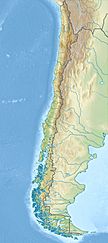Alsodes kaweshkari facts for kids
Quick facts for kids Alsodes kaweshkari |
|
|---|---|
| Conservation status | |
| Scientific classification |
Alsodes kaweshkari is a very rare type of frog that lives only in southern Chile. It belongs to the Alsodidae family. Scientists have only found two of these frogs so far. One was found in Puerto Edén on Wellington Island, and the other was found nearby on the mainland.
Contents
What's in a Name?
The special name kaweshkari comes from the Kaweshkar people. They are a brave group of people who hunt sea lions and live in Puerto Edén. This is the area where this unique frog was first discovered.
What Does It Look Like?
Both Alsodes kaweshkari frogs that scientists found were males. They were quite large for their kind, measuring about 56 to 62 millimeters from snout to vent. That's about 2 to 2.5 inches long!
Froggy Features
These frogs have a strong, sturdy body. Their skin on the back and sides feels bumpy or "granular." The skin on their belly is smooth. Their back, arms, and legs are brown. The areas around their nose, lips, and eyes are a lighter brown. Their eyes have a coppery pattern. The belly of the frog is a whitish-yellow color.
Special Details
These frogs do not have a visible eardrum, which is called a tympanum. Their toes have small fringes and a bit of webbing at the bottom. Their fingers do not have webbing. Male frogs have some small spines on their fingers. They also have black patches of spiny skin on their chest. These are special features that only male frogs have.
Sadly, the first frog specimen found, called the holotype, was destroyed in a fire in 2007.
Where Do They Live and Are They Safe?
Both places where Alsodes kaweshkari frogs were found have small forests. These forests are made up of trees like Nothofagus betuloides, Embothrium coccineum, Maytenus magellanica, and Drimys winteri. These forests are surrounded by open, grassy areas called tundra.
Their Home
One frog was found hiding under a log. This was right where the forest met the tundra. The other frog was found near a small stream. Both places were very close to the sea, only about 8 to 10 meters (26 to 33 feet) above sea level.
Conservation Status
The Alsodes kaweshkari frog was last seen in 1998. Scientists went back to the same area in 2001 and 2002 but could not find any more of these frogs. We don't know exactly what threatens them. However, we do know that they live inside the Bernardo O'Higgins National Park. This park helps protect the animals and plants that live there.
See also
 In Spanish: Rana kaweshkar para niños
In Spanish: Rana kaweshkar para niños



